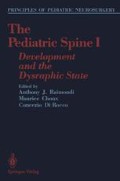Abstract
The goals of treatment for a child born with spina bifida include attainment of the highest possible level of functioning, maximum independence, and promotion of sound psychosocial development of the child, parents, and siblings.1
Access this chapter
Tax calculation will be finalised at checkout
Purchases are for personal use only
Preview
Unable to display preview. Download preview PDF.
References
L Colgan MT: Child with spina bifida: Am J Dis Child 135: 854–858, 1981.
Elwood JM, Elwood JH: Epidemiology of Anencephalus and Spina Bifida: Oxford University Press, New York, 1980.
Shurtleff DB: Myelodysplasias and Extrophies: Grune & Stratton, Orlando, FL, 1986.
McLaurin R, Oppenheimer S (eds): Myelomeningocele: A Multidisciplinary Approach: Greenwood Press, West Port, CT, 1986.
Lorber J: Results of treatment of myelomeningocele: an analysis of 524 unselected cases with special reference to possible selection for treatment. Dev Med Child Neurol 13: 279–303, 1971.
Johnson DE, Thompson TR, Aroskar M: Baby Doe rules: there are alternatives: AJDC, 138: 523–529, 1984.
Bricker D: Early Education of At-risk and Handicapped Infants, Toddlers and Preschool Children: Scott, Foresman, Glenview, IL, 1986.
Erikson E: Identity, Youth and Crisis: Norton, New York, 1968.
Olshansky S: Parents Responses to a Mentally Defective Child: Soc Casework, XLIII- 191–193, 1962.
Kapke K: Spina bifida: Mother-child relationship. Nursing Forum: IX: 310–319, 1970.
Schor D, Oppenheimer S: Interpreting Myelomeningocele to Parent: Long Term Effect of Initial Parent-Physician Contact: Presentation Academy Cerebral Palsy Meeting, October 1980.
Spina Bifida Association of America, 343 S. Dearborn St., Chicago, IL 60604.
Emde R, Kligman D, Reich J, et al: Emotional expression in infancy: I. Initial studies of social signaling and an emergent model. In: Lewis M, Rosenblum L (eds): Development of Affect: Plenum Press, New York, 1978.
Horn D, Lorch E, Lorch R, et al: Distractibility and vocabulary deficits in children with spina bifida and hydrocephalus. Dev Med Child Neurol 27: 713–720, 1985.
Anderson E, Spain B: The Child with Spina Bifida: London, Methuen & Co, 1977, pp. 117–141, 205.
Baron I, Spiegler B: Neuropsychological assessment of the child with spina bifida: Clin Proc CHMC 38: 196–201, 1982.
Lorton A: Hand preference in children with myelomeningocele and hydrocephalus. Dev Med Child Neurol 18: 143–148, 1976.
Dorner S: Adolescents with spina bifida: how they see their situation. Arch Dis Child 51: 539–544, 1976.
Dorner S: The relationship of physical handicap to stress in families with an adolescent with spina bifida. Dev Med Child Neurol 17: 765–776, 1975.
White W: Motivation reconsidered: the concept of competence. Psychol Rev 297–333, 1959.
Campbell W, Hayden PW, Davenport SL: Psychological adjustment of adolescents with myelodysplasia. J Youth Adolesc 6: 397–407, 1977.
Eckart ML: Correlates of Self Esteem in Children with Myelomeningocele: Masters’ Thesis, Department of Psychology, University of Cincinnati, 1986.
Bray R, Shurtleff, DB: Psychosocial implications of myelodysplasia: Clin Res 20: 82–86, 1972.
Dorner S: Psychological and social problems of families of adolescent spina bifida patients: a preliminary report. Dev Med Child Neurol 15:Supp. 129.
Dunne KB, Shurtleff DB: The adult with meningomyelocele: A preliminary report: In: McLauren R, Oppenheimer S (eds): Myelomeningocele: A Multidisciplinary Approach. Greenwood Press, West Port, CT, 1986.
Editor information
Editors and Affiliations
Rights and permissions
Copyright information
© 1989 Springer-Verlag New York Inc.
About this chapter
Cite this chapter
Oppenheimer, S. (1989). Social, Psychologic, and Educational Problems. In: Raimondi, A.J., Choux, M., Di Rocco, C. (eds) The Pediatric Spine I. Principles of Pediatric Neurosurgery. Springer, New York, NY. https://doi.org/10.1007/978-1-4613-8820-3_12
Download citation
DOI: https://doi.org/10.1007/978-1-4613-8820-3_12
Publisher Name: Springer, New York, NY
Print ISBN: 978-1-4613-8822-7
Online ISBN: 978-1-4613-8820-3
eBook Packages: Springer Book Archive

